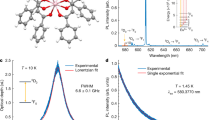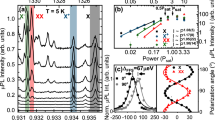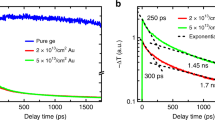Abstract
Atomic defects in the solid state are a key component of quantum repeater networks for long-distance quantum communication1. Recently, there has been significant interest in rare earth ions2,3,4, in particular Er3+ for its telecom band optical transition5,6,7 that allows long-distance transmission in optical fibres. However, the development of repeater nodes based on rare earth ions has been hampered by optical spectral diffusion, precluding indistinguishable single-photon generation. Here, we implant Er3+ into CaWO4, a material that combines a non-polar site symmetry, low decoherence from nuclear spins8 and is free of background rare earth ions, to realize significantly reduced optical spectral diffusion. For shallow implanted ions coupled to nanophotonic cavities with large Purcell factor, we observe single-scan optical linewidths of 150 kHz and long-term spectral diffusion of 63 kHz, both close to the Purcell-enhanced radiative linewidth of 21 kHz. This enables the observation of Hong–Ou–Mandel interference9 between successively emitted photons with a visibility of V = 80(4)%, measured after a 36 km delay line. We also observe spin relaxation times T1,s = 3.7 s and T2,s > 200 μs, with the latter limited by paramagnetic impurities in the crystal instead of nuclear spins. This represents a notable step towards the construction of telecom band quantum repeater networks with single Er3+ ions.
This is a preview of subscription content, access via your institution
Access options
Access Nature and 54 other Nature Portfolio journals
Get Nature+, our best-value online-access subscription
$29.99 / 30 days
cancel any time
Subscribe to this journal
Receive 51 print issues and online access
$199.00 per year
only $3.90 per issue
Buy this article
- Purchase on Springer Link
- Instant access to full article PDF
Prices may be subject to local taxes which are calculated during checkout




Similar content being viewed by others
Data availability
Data for all figures are available from the Harvard Dataverse repository (https://doi.org/10.7910/DVN/YLXVLB).
References
Awschalom, D. D., Hanson, R., Wrachtrup, J. & Zhou, B. B. Quantum technologies with optically interfaced solid-state spins. Nat. Photon. 12, 516–527 (2018).
Simon, C. et al. Quantum memories. Eur. Phys. J. D. 58, 1–22 (2010).
Zhong, T. et al. Optically addressing single rare-earth ions in a nanophotonic cavity. Phys. Rev. Lett. 121, 183603 (2018).
Kindem, J. M. et al. Control and single-shot readout of an ion embedded in a nanophotonic cavity. Nature 580, 201–204 (2020).
Dibos, A. M., Raha, M., Phenicie, C. M. & Thompson, J. D. Atomic source of single photons in the telecom band. Phys. Rev. Lett. 120, 243601 (2018).
Ulanowski, A., Merkel, B. & Reiserer, A. Spectral multiplexing of telecom emitters with stable transition frequency. Sci. Adv. 8, eabo4538 (2022).
Yang, L., Wang, S., Shen, M., Xie, J. & Tang, H. X. Controlling single rare earth ion emission in an electro-optical nanocavity. Nat. Commun. 14, 1718 (2023).
LeDantec, M. et al. Twenty-three-millisecond electron spin coherence of erbium ions in a natural-abundance crystal. Sci. Adv. 7, eabj9786 (2021).
Hong, C. K., Ou, Z. Y. & Mandel, L. Measurement of subpicosecond time intervals between two photons by interference. Phys. Rev. Lett. 59, 2044–2046 (1987).
Awschalom, D. et al. Development of quantum interconnects (quics) for next-generation information technologies. PRX Quantum 2, 017002 (2021).
Briegel, H.-J., Dür, W., Cirac, J. I. & Zoller, P. Quantum repeaters: the role of imperfect local operations in quantum communication. Phys. Rev. Lett. 81, 5932–5935 (1998).
Togan, E. et al. Quantum entanglement between an optical photon and a solid-state spin qubit. Nature 466, 730–734 (2010).
De Greve, K. et al. Quantum-dot spin-photon entanglement via frequency downconversion to telecom wavelength. Nature 491, 421 (2012).
Sun, S., Kim, H., Luo, Z., Solomon, G. S. & Waks, E. A single-photon switch and transistor enabled by a solid-state quantum memory. Science 361, 57–60 (2018).
Bernien, H. et al. Heralded entanglement between solid-state qubits separated by three metres. Nature 497, 86–90 (2013).
Kalb, N. et al. Entanglement distillation between solid-state quantum network nodes. Science 356, 928–932 (2017).
Bhaskar, M. K. et al. Experimental demonstration of memory-enhanced quantum communication. Nature 580, 60–64 (2020).
Li, Q., Davanço, M. & Srinivasan, K. Efficient and low-noise single-photon-level frequency conversion interfaces using silicon nanophotonics. Nat. Photon. 10, 406–414 (2016).
Stolk, A. et al. Telecom-band quantum interference of frequency-converted photons from remote detuned NV centers. PRX Quantum 3, 020359 (2022).
Saglamyurek, E. et al. Quantum storage of entangled telecom-wavelength photons in an erbium-doped optical fibre. Nat. Photon. 9, 83–87 (2015).
Craiciu, I. et al. Nanophotonic quantum storage at telecommunication wavelength. Phys. Rev. Appl. 12, 024062 (2019).
Lago-Rivera, D., Grandi, S., Rakonjac, J. V., Seri, A. & de Riedmatten, H. Telecom-heralded entanglement between multimode solid-state quantum memories. Nature 594, 37–40 (2021).
Businger, M. et al. Non-classical correlations over 1,250 modes between telecom photons and 979-nm photons stored in 171Yb3+:Y2SiO5. Nat. Commun. 13, 6438 (2022).
Rančić, M., Hedges, M. P., Ahlefeldt, R. L. & Sellars, M. J. Coherence time of over a second in a telecom-compatible quantum memory storage material. Nat. Phys. 14, 50–54 (2018).
Böttger, T., Thiel, C. W., Cone, R. L. & Sun, Y. Effects of magnetic field orientation on optical decoherence in Er3+:Y2SiO5. Phys. Rev. B 79, 115104 (2009).
Zhong, M. et al. Optically addressable nuclear spins in a solid with a six-hour coherence time. Nature 517, 177–180 (2015).
Ortu, A. et al. Simultaneous coherence enhancement of optical and microwave transitions in solid-state electronic spins. Nat. Mater. 17, 671–675 (2018).
Kindem, J. M. et al. Characterization of 171Yb3+:YVO4 for photonic quantum technologies. Phys. Rev. B 98, 024404 (2018).
Raha, M. et al. Optical quantum nondemolition measurement of a single rare earth ion qubit. Nat. Commun. 11, 1605 (2020).
Kornher, T. et al. Sensing individual nuclear spins with a single rare-earth electron spin. Phys. Rev. Lett. 124, 170402 (2020).
Ruskuc, A., Wu, C.-J., Rochman, J., Choi, J. & Faraon, A. Nuclear spin-wave quantum register for a solid-state qubit. Nature 602, 408–413 (2022).
Uysal, M. T. et al. Coherent control of a nuclear spin via interactions with a rare-earth ion in the solid state. PRX Quantum 4, 010323 (2023).
Thiel, C. W., Böttger, T. & Cone, R. L. Rare-earth-doped materials for applications in quantum information storage and signal processing. J. Lumin. 131, 353–361 (2011).
Zhong, T. & Goldner, P. Emerging rare-earth doped material platforms for quantum nanophotonics. Nanophotonics 8, 2003–2015 (2019).
Phenicie, C. M. et al. Narrow optical line widths in erbium implanted in TiO2. Nano Lett. 19, 8928–8933 (2019).
Stevenson, P. et al. Erbium-implanted materials for quantum communication applications. Phys. Rev. B 105, 224106 (2022).
Ferrenti, A. M., de Leon, N. P., Thompson, J. D. & Cava, R. J. Identifying candidate hosts for quantum defects via data mining. npj Computat. Mater. 6, 126 (2020).
Nassau, K. & Loiacono, G. Calcium tungstate-III: Trivalent rare earth ion substitution. J. Phys. Chem. Solids 24, 1503–1510 (1963).
Enrique, B. G. Optical spectrum and magnetic properties of Er3+ in CaWO4. J. Chem. Phys. 55, 2538–2549 (1971).
Sun, Y., Thiel, C., Cone, R., Equall, R. & Hutcheson, R. Recent progress in developing new rare earth materials for hole burning and coherent transient applications. J. Lumin. 98, 281–287 (2002).
Chen, S. et al. Hybrid microwave-optical scanning probe for addressing solid-state spins in nanophotonic cavities. Optics Expr. 29, 4902 (2021).
Chen, S., Raha, M., Phenicie, C. M., Ourari, S. & Thompson, J. D. Parallel single-shot measurement and coherent control of solid-state spins below the diffraction limit. Science 370, 592–595 (2020).
Santori, C., Fattal, D., Vucković, J., Solomon, G. S. & Yamamoto, Y. Indistinguishable photons from a single-photon device. Nature 419, 594 (2002).
Barrett, S. D. & Kok, P. Efficient high-fidelity quantum computation using matter qubits and linear optics. Phys. Rev. A 71, 060310 (2005).
Zhao, T.-M. et al. Entangling different-color photons via time-resolved measurement and active feed forward. Phys. Rev. Lett. 112, 103602 (2014).
Asano, T., Ochi, Y., Takahashi, Y., Kishimoto, K. & Noda, S. Photonic crystal nanocavity with a Q factor exceeding eleven million. Optics Express 25, 1769 (2017).
Hu, S. & Weiss, S. M. Design of photonic crystal cavities for extreme light concentration. ACS Photonics 3, 1647–1653 (2016).
Collins, O. A., Jenkins, S. D., Kuzmich, A. & Kennedy, T. A. B. Multiplexed memory-insensitive quantum repeaters. Phys. Rev. Lett. 98, 060502 (2007).
Wang, Z. et al. Single electron-spin-resonance detection by microwave photon counting. Preprint at https://arxiv.org/abs/2301.02653 (2023).
Ziegler, J. F., Ziegler, M. D. & Biersack, J. P. SRIM - The stopping and range of ions in matter (2010). Nucl. Instrum. Methods Phys. Res. B. Beam Interact. Mater. Atoms 268, 1818–1823 (2010).
Carnall, W. T., Goodman, G. L., Rajnak, K. & Rana, R. S. A systematic analysis of the spectra of the lanthanides doped into single crystal LaF3. J. Chem. Phys. 90, 3443–3457 (1989).
Wybourne, B. G. Spectroscopic Properties of Rare Earths (Interscience Publishers, 1965).
Newman, D. Theory of lanthanide crystal fields. Adv. Phys. 20, 197–256 (1971).
Messiah, A. Quantum Mechanics (Dover Publications, 1961).
Suter, D. & Álvarez, G. A. Colloquium: Protecting quantum information against environmental noise. Rev. Mod. Phys. 88, 041001 (2016).
Kambs, B. & Becher, C. Limitations on the indistinguishability of photons from remote solid state sources. New J. Phys. 20, 115003 (2018).
Loredo, J. C. et al. Scalable performance in solid-state single-photon sources. Optica 3, 433 (2016).
Abragam, A. & Bleaney, B. Electron Paramagnetic Resonance of Transition Ions (OUP, 1970).
Yang, W. & Liu, R.-B. Quantum many-body theory of qubit decoherence in a finite-size spin bath. ii. ensemble dynamics. Phys. Rev. B 79, 115320 (2009).
de Wit, M., Welker, G., de Voogd, J. & Oosterkamp, T. Density and T 1 of surface and bulk spins in diamond in high magnetic field gradients. Phys. Rev. Appl. 10, 064045 (2018).
Dwyer, B. L. et al. Probing spin dynamics on diamond surfaces using a single quantum sensor. PRX Quantum 3, 040328 (2022).
Acknowledgements
We acknowledge helpful conversations with C. Thiel, P. Goldner and M. Rančić. This work was primarily supported by the US Department of Energy (DOE), Office of Science, National Quantum Information Science Research Centers, Co-design Center for Quantum Advantage (C2QA) under contract number DE-SC0012704. We also acknowledge support from the DOE Early Career award (grant no. DE-SC0020120, for modelling of decoherence mechanisms and spin interactions), as well as AFOSR (grant nos. FA9550-18-1-0334 and YIP FA9550-18-1-0081), the Eric and Wendy Schmidt Transformative Technology Fund, the Princeton Catalysis Initiative and DARPA DRINQS (grant no. D18AC00015) for establishing the materials spectroscopy pipeline and developing integrated nanophotonic devices. We acknowledge the use of Princeton’s Imaging and Analysis Center, which is partially supported by the PCCM, an NSF MRSEC (grant no. DMR-1420541), as well as the Princeton Micro-Nano Fabrication Center.
Author information
Authors and Affiliations
Contributions
S.O., Ł.D., S.P.H. and M.T.U. performed the experiments in the main text and analysed the data. S.P.H., C.M.P. and P.S. developed the materials used in this work, including ion implantation and annealing techniques. C.M.P., M.R. and S.C. performed initial spectroscopy of single erbium ions in CaWO4, together with S.O., Ł.D., S.P.H. and M.T.U. R.J.C. and N.P.d.L. supervised the materials development, and J.D.T. developed the project concept and supervised all aspects of the work. S.O., Ł.D., S.P.H., M.T.U., N.P.d.L. and J.D.T. wrote and edited the manuscript, with input from all authors.
Corresponding author
Ethics declarations
Competing interests
The authors declare no competing interests.
Peer review
Peer review information
Nature thanks Rose Ahlefeldt and the other, anonymous, reviewer(s) for their contribution to the peer review of this work.
Additional information
Extended data
is available for this paper at https://doi.org/10.1038/s41586-023-06281-4.
Publisher’s note Springer Nature remains neutral with regard to jurisdictional claims in published maps and institutional affiliations.
Extended data figures and tables
Extended Data Fig. 1 Ensemble PLE dependence on annealing.
Blue: the ensemble PLE intensity for a high density sample. Orange: the PLE intensity recorded for the same sample after annealing at a temperature of 300 °C for 1 hour, revealing a 5x increase in fluorescence intensity. This data was obtained using a sample cooled to 4K.
Extended Data Fig. 2 Ensemble spectroscopy of Er3+:CaWO4.
a Site-selective excitation spectrum of Er3+:CaWO4. Green arrows indicate when the excitation laser is resonant with different excited state crystal-field levels, where the corresponding excitation path is labeled using the matching number in (b). Solid orange arrows denote the fluorescence energies due to decay from the 4I13/2Y1 level, whereas the dashed arrows denote decay from the 4I13/2Y2 level. No other Er3+ sites were observed. The prominent line with unity gradient corresponds to laser scatter and has been re-scaled in intensity for clarity. b Assigned transitions. The performed spectroscopy yielded energies of four 4I15/2 and three 4I13/2 levels.
Extended Data Fig. 3 Measuring the cyclicity.
a Decay of the A transition fluorescence count rate from optical pumping after initializing into \(\left|{\uparrow }_{g}\right\rangle \) (blue). The count rate decays as e−n/C revealing a cyclicity of C = 1030(10). The orange trace corresponds to the same readout pulse sequence after initializing into \(\left|{\downarrow }_{g}\right\rangle \). b Intensity autocorrelation g(2)(t1 − t2) of the A transition showing strong suppression of the zero-delay peak with g(2)(0) = 0.018(3).
Extended Data Fig. 4 Optical coherence of Er3+:CaWO4.
a Timing sequence for an optical Hahn echo experiment. The ion is initialized into \(\left|{\uparrow }_{g}\right\rangle \) state using 10 pairs of optical πB and microwave πMWe pulses. b An optical Hahn echo measurement (green) reveals an optical coherence of T2,o = 10.2 μs. Applying XY32 dynamical decoupling sequence (orange) extends the optical coherence to the radiative limit (blue dashed line) T2,o = 18 μs, at a field where the optical T1,o = 9.1(3) μs. c Timing sequence for an optical XYN experiment. d Dephasing rate scaling with the number of refocusing pulses of XY dynamical decoupling sequences (red) compared to the lifetime limit (blue).
Extended Data Fig. 5 Spin lifetime as a function of magnetic field strength.
Solid line is a fit to Eq. (14) as is predicted for the spin-lattice relaxation time.
Extended Data Fig. 6 W bath limited coherence.
a The second order contribution to the CCE simulation for the Hahn experiment for 10 random W-bath configurations, where we assume that the nearest W nuclear spin is located at rW. Fitting each of the curves to a stretched exponential yields T2,s = 22.7(4) ms with n = 2.7(1). We note that this is only the envelope and faster ESEEM features, obtained from the first order CCE simulation, persist as seen in Fig. 4d. This simulation considers W nuclear spins within an 11 nm radius of the Er3+ spin. b CCE simulation of Ramsey experiment for the same W bath configurations. Fitting each of the curves to a Gaussian decay yields \({T}_{2,{\rm{s}}}^{* }=4.0(4)\,\mu s\). Both simulations are performed at our experimental field configuration.
Extended Data Fig. 7 Probability density of paramagnetic impurity concentration.
a Assuming a 3D uniform distribution of impurities, we estimate that the bath concentration is in the range 1.6 × 1016 – 5.7 × 1016 cm−3 with 70% confidence, with the likeliest concentration at 3.7 × 1016 cm−3. b Assuming a 2D distribution on the surface of our crystal, assumed to be located 10 nm away from the Er3+ spin, we estimate an area concentration in the range of 0.5–1.3 nm−2 with 70% confidence, with the likeliest concentration at 0.77 nm−2. Dashed lines indicate the confidence ranges for the impurity concentrations.
Rights and permissions
Springer Nature or its licensor (e.g. a society or other partner) holds exclusive rights to this article under a publishing agreement with the author(s) or other rightsholder(s); author self-archiving of the accepted manuscript version of this article is solely governed by the terms of such publishing agreement and applicable law.
About this article
Cite this article
Ourari, S., Dusanowski, Ł., Horvath, S.P. et al. Indistinguishable telecom band photons from a single Er ion in the solid state. Nature 620, 977–981 (2023). https://doi.org/10.1038/s41586-023-06281-4
Received:
Accepted:
Published:
Issue Date:
DOI: https://doi.org/10.1038/s41586-023-06281-4
This article is cited by
-
Cavity-coupled telecom atomic source in silicon
Nature Communications (2024)
-
Light–matter interactions in quantum nanophotonic devices
Nature Reviews Physics (2024)
-
Telecom-band quantum dot technologies for long-distance quantum networks
Nature Nanotechnology (2023)
Comments
By submitting a comment you agree to abide by our Terms and Community Guidelines. If you find something abusive or that does not comply with our terms or guidelines please flag it as inappropriate.



